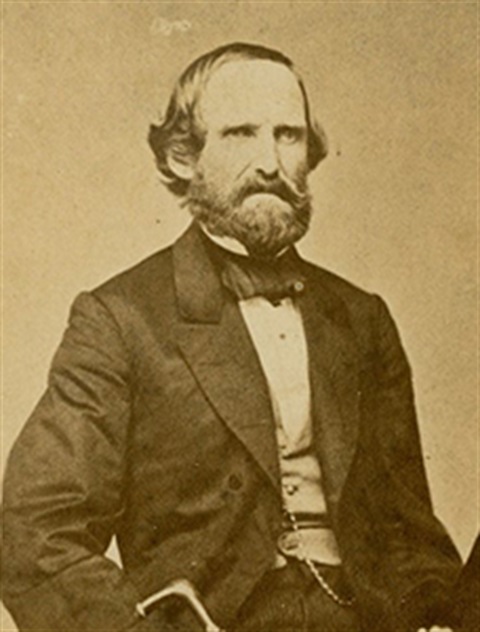Benjamin McCulloch

1811 - 1862
Benjamin McCulloch was born November 11, 1811 in Rutherford County, Tennessee. The family moved often living in North Carolina, Alabama and Tennessee during the years 1812 -1830. Late in 1835 he and his brother Henry, made their way to Texas. Arriving after the fall of the Alamo, Ben joined the Texan army. At San Jacinto he manned one of the cannon known as the "twin sisters." He won praise and a battlefield promotion from Sam Houston and a poem was written about his exploits, "Ben McCulloch at San Jacinto."
He soon left the army and settled at Gonzales, working as a surveyor. While here he met up with and joined Jack Hays' company of Rangers. He was involved in many fights with the Indians including the battle of Plum Creek in 1840, and in the expedition against the Indians located along the tributaries of the Guadalupe river in 1841. In 1842 he was elected as 1st Lieutenant in Jack Hays' company of Rangers.
At the outbreak of the Mexican War McCulloch raised a command that became Company A of Col. Jack Hays' First Regiment, Texas Mounted volunteers. Showing great skill in tracking and scouting, he was named Gen. Zachary Taylor's chief of scouts. He and his men rendered invaluable service to the U. S. Army at the battles of Monterey and Buena Vista. He ended the war with the rank of major.
Returning to Texas at the end of the war, McCulloch resumed his business of surveying. Catching the "gold fever" he traveled to Sacramento, California in 1849 where he served as sheriff. In 1852 he returned to Texas and was appointed U.S. Marshal for the Eastern District of Texas. In 1857 he was appointed as one of the commissioners charged with investigating the Mormon troubles in Utah.
At the outbreak of the Civil War he offered his services to the Confederacy and was commissioned a brigadier-general in May 1861 and ordered to Fort Smith, Arkansas. McCulloch, commanding the Confederate right wing in the Battle of Pea Ridge, March 7, 1862, overran and drove the Union forces from their position. Riding through the undergrowth to ascertain the new Union position, McCulloch was shot and killed.
McCulloch was originally buried on the field, but later moved to the cemetery at Little Rock, Arkansas and finally to the Texas State Cemetery in Austin, Texas.
McCulloch is one of the original Hall of Fame inductees from February 6, 1976.
Suggestions for further reading:
- McCulloch Papers, Center for American History, University of Texas, Austin, Texas
- Rossiter Johnson, The twentieth century dictionary of notable Americans, Boston: The Biographical Society, 1904, vol. VII
- The new handbook of Texas, Austin: The Texas State Historical Commission, 1996, vol. 4
- Amelia Williams and Eugene Barker, The writings of Sam Houston, Austin: Pemeberton Press, 1970, vol. V
- Thomas W. Cutter, Ben McCulloch and the frontier military tradition, Chapel Hill: University of North Carolina Press, 1993
- Darren Ivey, The Ranger Ideal Volume 1: Texas Rangers in the Hall of Fame, 1823 – 1861, UNT, 2017
- Vertical file, Texas Ranger Research Collection, Texas Ranger Hall of Fame and Museum, Waco, Texas